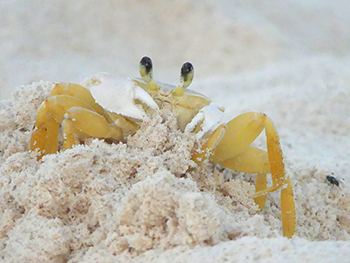As soon as the last human feet leave the beach and the sun sends its last rays onto the land, a completely different world wakes up and starts living its life.
Anyone who has a little patience and pays attention to the small details of the beach (and then we are talking about beaches that are more or less deserted after sunset) will see that a living organism crawls out of almost every nook and cranny. It is nice to stay on a sandy beach after people have left it. The human species is very good at leaving all kinds of rubbish behind, among which there is a lot of edible stuff for a wide variety of animals. And in addition, there is also a lot of naturally present food in the form of organic material that is washed up by the sea, such as seaweed or sea grass, sand fleas and other tasty things.
One of the animal species that ‘wakes up’ when people have left is the so-called Atlantic Ghost Crab, or the yellowish, almost transparent sand crab as we call them here. This crab species is a common sight on beaches in the Caribbean and along South and Central America. This crab lives in holes in the sand above the beach line. These are not just any holes. Some crabs dig them to a depth of more than a meter. The hole is a place where the animals hide during the warm hours of the day. The sand is always moist and therefore cool, deeper underground.
These sand crabs are true omnivores. Insects, plant material, shellfish and even other crabs are on the menu. And in addition, food remains that humans leave behind. On the other hand, night herons do like a juicy sand crab for dinner.
In many places where this crab occurs, the species is not doing well. Due to intensive use of beaches, including vehicles driving on the sand, many crabs are literally crushed to death and their reproductive cycle is also interrupted.
English name: Atlantic Ghost Crab
Papiamentu name: Kangreu
Scientific name: Ocypode quadrata
Family: Ocypodidae (Ghost and fiddler crabs)
Occurrence (ABC islands): Aruba, Bonaire and Curaçao

De ‘Atlantic Ghost Crab’

Zodra de laatste mensenvoeten van het strand vertrekken en de zon zo’n beetje zijn laatste zonnestralen laat schijnen op het land, wordt er een totaal andere wereld wakker en gaat zijn leven leiden.
Wie een beetje geduld heeft en met aandacht voor het kleine detailwerk het strand nauwlettend in de gaten houdt (en dan gaat het om stranden die na zonsondergang min of meer verlaten zijn), ziet dat bijna uit elk hoekje en gaatje wel een levend organisme komt kruipen. Het is namelijk goed toeven op een zandstrand nadat de mensen deze hebben verlaten. De soort mens is namelijk heel goed in het achterlaten van allerlei rommel waartussen een heleboel eetbaars zit. En daarnaast is er ook een heleboel van nature aanwezig voedsel, organisch materiaal dat door de zee wordt aangespoeld in de vorm van bijvoorbeeld zeewier of zeegras, zandvlooien en ander lekkers.
Een van de diersoorten die ‘wakker’ wordt als de mensen zijn vertrokken zijn de zogenaamde Atlantic Ghost Crab, of de gelige bijna doorschijnende zandkrab zoals we ze hier wel noemen. Deze krabbensoort is een algemene verschijning op stranden in het Caribisch gebied en langs Zuid en Midden-Amerika. Deze krab leeft in holen in het zand boven de strandlijn. Dit zijn niet zomaar gaten. Sommige krabben graven ze namelijk tot meer dan een meter diep. Het hol is een plek waar de dieren zich schuil houden tijdens de warme uren van de dag. Het zand is namelijk altijd vochtig en dus koel, dieper onder de grond.
Deze zandkrabben zijn echte alleseters. Insecten, plantaardig materiaal, schelpdieren en zelfs andere krabben staan op het menu. En daarnaast voedselresten die de mens achterlaat. Daar staat tegenover dat nachtreigers wel een sappige zandkrab lusten als diner.
Op veel plekken waar deze krab voorkomt gaat het niet goed met de soort. Door intensief gebruik van stranden waarbij ook met voertuigen op het zand wordt gereden, worden veel krabben letterlijk dood gedrukt en wordt ook hun voortplantingscyclus doorbroken.
Nederlandse naam: Zandkrab
Papiamentse naam: Kangreu
Wetenschappelijke naam: Ocypode quadrata
Familie: Ocypodidae (Spook en wenkkrabben)
Voorkomen (ABC eilanden): Aruba, Bonaire en Curaçao